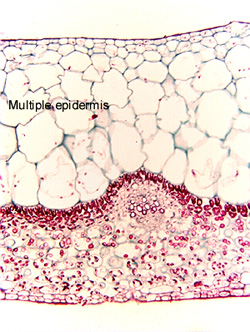 Fig.
10.6-3.
Transverse section of leaf of peperomia (Peperomia). Like fig (Ficus),
this species has a thick multiseriate upper epidermis. The cells of the multiple
epidermis are clear, both here and while the leaf is alive. The lower portion of
the leaf consists of palisade parenchyma and spongy mesophyll, stained red here
but green when the leaf is alive. Leaves of peperomias are usually so thick that
if you simply cut one in half (they also snap in two easily), you can see the
clear upper part and green lower part.
Fig.
10.6-3.
Transverse section of leaf of peperomia (Peperomia). Like fig (Ficus),
this species has a thick multiseriate upper epidermis. The cells of the multiple
epidermis are clear, both here and while the leaf is alive. The lower portion of
the leaf consists of palisade parenchyma and spongy mesophyll, stained red here
but green when the leaf is alive. Leaves of peperomias are usually so thick that
if you simply cut one in half (they also snap in two easily), you can see the
clear upper part and green lower part.